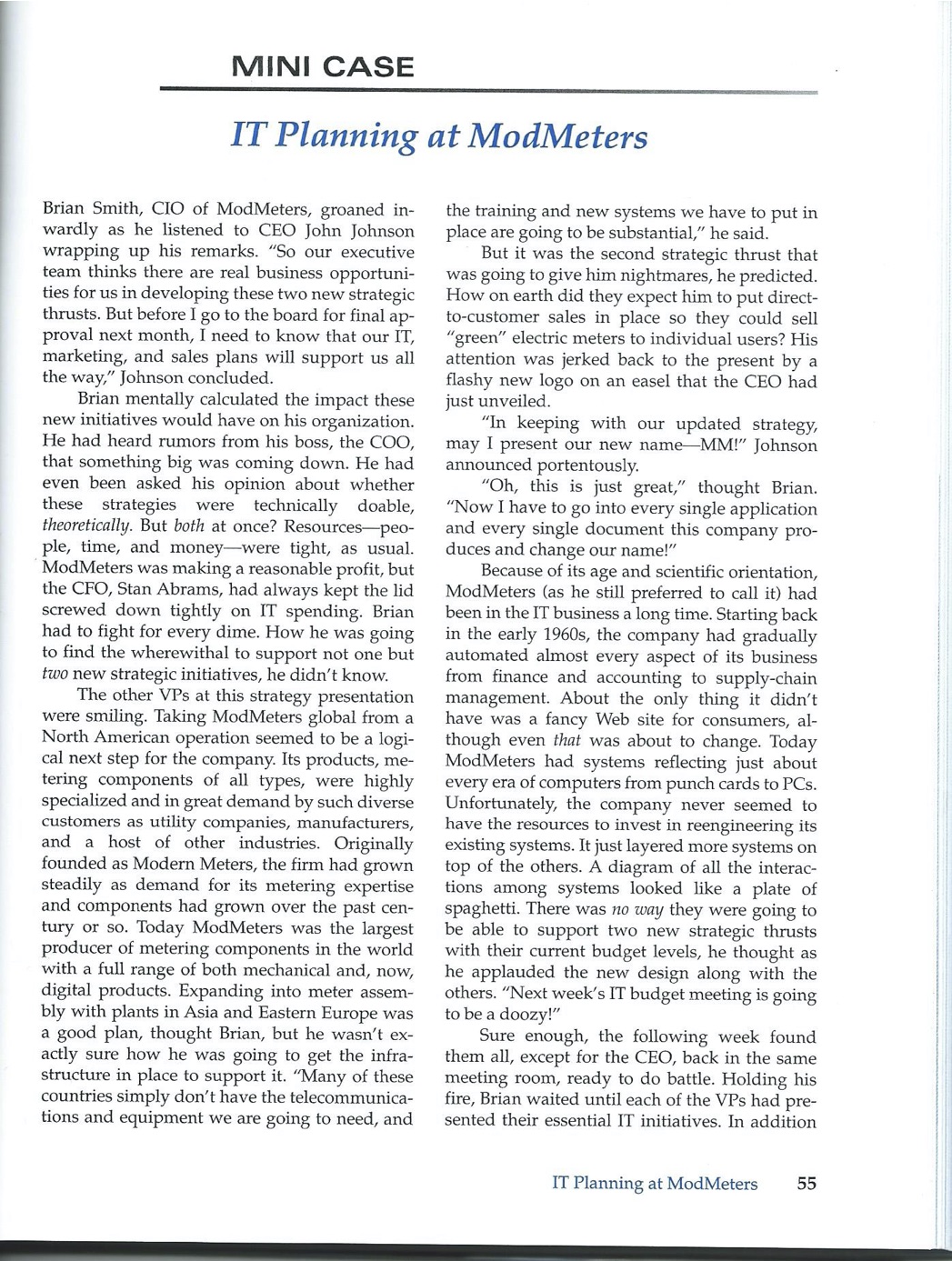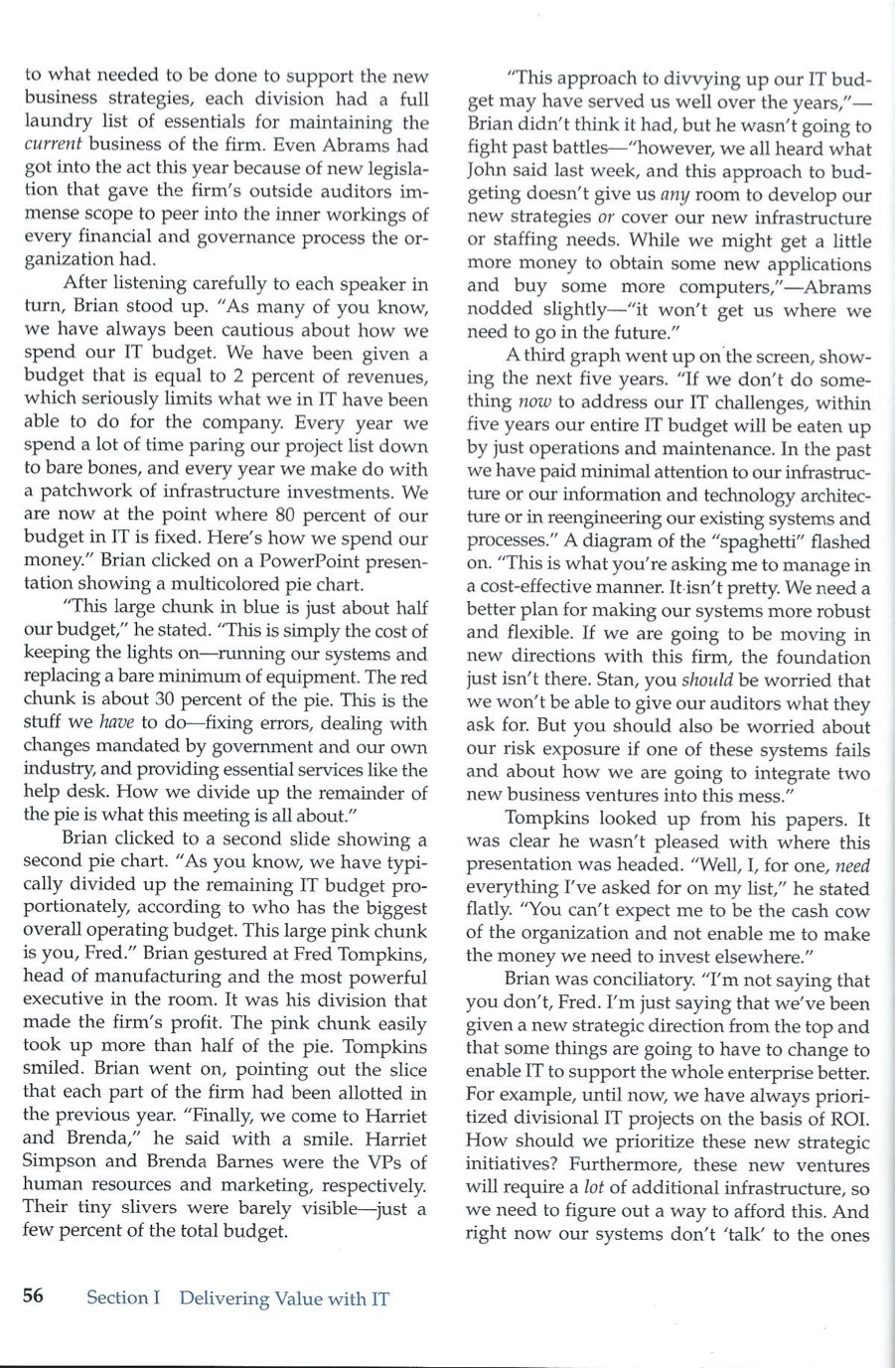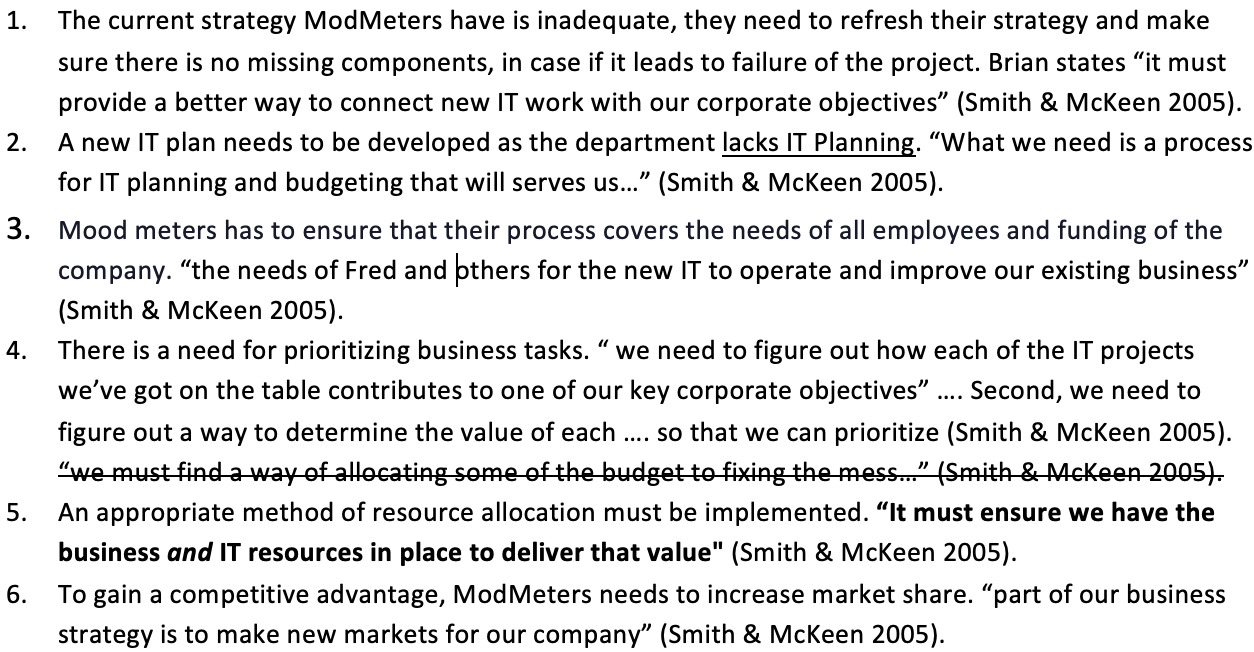Hi, I want to check if i meet the following requirement as this is for a report. This is based on the attached case study.
The main question is: Develop an IT Planning process for ModMeters to accomplish the demands as set out in the case study, but before answering this question the requirement is: List The Demands
Demand 1 - clear statement supported with direct quote/s from the Case Study. Demand 2 - clear statement supported with direct quote/s from the Case Study ..... ..... Etc.........
I want to check if my statements are clear and supported with correct direct quotes. If not, could you please mention which ones are not and how i can improve.
MINI CASE IT Planning at ModMeters Brian Smith, CIO of ModMeters, groaned in- wardly as he listened to CEO John Johnson wrapping up his remarks. \"So our executive team thinks there are real business opportuni- ties for us in developing them two new strategic thrusts. But before I go to the board for final ap- proval next month, I need to know that our IT, marketing, and sales plans will support us all the way\" Johnson concluded. Brian mentally calculated the impact these new initiatives would have on his organization. He had heard tumors from his boss, the C00, that something big was coming down. He had even been asked his Opinion about whether these strategies were technically doable, theoretically. But both at once? Resourcespeo- ple, time, and moneywere tight, as usual. ' ModMeters was making a reasonable prot, but the CFO, Stan Abrams, had always kept the lid screwed down tightly 0n IT spending. Brian had to ght for every dime. How he was going to find the wherewithal to support not one but two new strategic initiatives, he didn't know. The other We at this strategy presentation were smiling. Taking ModMeters global from a North American operation seemed to be a logi- cal next step for the company. Its products, me- tering components of all types, were highly specialized and in great demand by such diverse customers as utility companies, manufacturers, and a host of other industries. Originally founded as Modem Meters, the firm had grown steadily as demand for its metering expertise and components had grown over the past cen- tury or so. Today ModMeters was the largest producer of metering components in the world with a full range of both mechanical and, now, digital products. Expanding into meter assem- bly with plants in Asia and Eastern Europe was a good plan, thought Brian, but he waSn't ex- actly sure how he was going to get the infra- structure in place to support it. 'Many of these countries simply don't have the telecommunica- tions and equipment we are going to need, and the training and new systems we have to put in place are going to be substantial,\" he said. But it was the second strategic thrust that was going to give him nightmares, he predicted. How on earth did they expect him to put direct to-customer sales in place so they could sell \"green" electric meters to individual users? His attention was jerked back to the present by a ashy new logo on an easel that the CEO had just unveiled. \"In keeping with our updated strategy, may I present our new namEHMM!\" Johnson announced portentously. \"Oh, this is just great,\" thought Brian. "Now I have to go into every single application and every single document this company pro- duces and change our name!\" Because of its age and scientic orientatiOn, ModMeters {as he still preferred to call it) had been in the IT business a long time. Starting back in the early 1960's, the company had gradually automated almost every aspect of its business from nance and accounting to supply-chain management. About the only thing it didn't have was a fancy Web site for consumers, al- though even that was ab0ut to change. Today ModMeters had systems reecting just about every era of computers from punch cards to PCs. Unfortunately, the company never seemed to have the resources to invest in reengineering its existing systems. It just layered more systems on top of the others. A diagram of all the interac- tions among systems looked like a plate of spaghetti. There was no way they were going to be able to support two new strategic thrusts with their current budget levels, he thought as he applauded the new design along with the others. "Next week's IT budget meeting is going to be a doozy!\" Sure enough, the following week found them all, except for the CEO, back in the same meeting room, ready to do battle. Holding his fire, Brian waited until each of the VP5 had pre- sented their essential IT initiatives. In addition IT Planning at ModMeters 55 E | to what needed to be done to support the new business strategies, each division had a full laundry list of essentials for maintaining the current business of the firm. Even Abrams had got into the act this year because of new legisla- tion that gave the firm's outside auditors im- mense scope to peer into the inner workings of every financial and governance process the or- ganization had. After listening carefully to each speaker in turn, Brian stood up. "As many of you know, we have always been cautious about how we spend our IT budget. We have been given a budget that is equal to 2 percent of revenues, which seriously limits what we in IT have been able to do for the company. Every year we spend a lot of time paring our project list down to bare bones, and every year we make do with a patchwork of infrastructure investments. We are now at the point where 80 percent of our budget in IT is fixed. Here's how we spend our money.\" Brian clicked on a PowerPoint presen- tation showing a multicolored pie chart. \"This large chunk in blue is just about half our budget,\" he stated. \"This is simply the cost of keeping the lights onrunning our systems and replacing a bare minimum of equipment. The red chunk is about 30 percent of the pie. This is the stuff we have to Clofixing errors, dealing with changes mandated by gOvernment and our own industry, and providing essential services like the help desk. How we divide up the remainder of the pie is what this meeting is all about. \" Brian clicked to a second slide showing a second pie chart. \"As you know, we have typi- cally divided up the remaining IT budget pro- portionately, according to who has the biggest overall operating budget. This large pink chunk is you, Fred.\" Brian gestured at Fred Tompkins, head of manufacturing and the most powerful executive in the worn. It was his division that made the firm's profit. The pink chunk easily took up more than half of the pie. Tompkins smiled. Brian went on, pointing out the slice that each part of the firm had been allotted in the previous year. \"Finally, we come to Harriet and Brenda,\" he said with a smile. Harriet Simpson and Brenda Barnes were the VP5 of human resources and marketing, respectively. Their tiny slivers were barely Visiblejust a few percent of the total budget. 56 Section 1 Delivering Value with IT \"This approach to divvying up our IT bud- get may have served us well over the years,\" Brian didn't think it had, but he wasn't going to fight past battles\"however, we all heard what John said last week, and this approach to bud geting doesn't give us any room to develop our new strategies or cover our new infrastructure or staffing needs. While we might get a little more money to obtain some new applications and buy some more computers,"Abrams nodded slightly~"it won't get us where we need to go in the future.\" A third graph went up entire screen, show ing the next five years. "If we don't do some- thing now to address our IT challenges, within five years our entire IT budget will be eaten up by just operations and maintenance. In the past we have paid minimal attention to our infrastruc- ture or our information and technology architec- ture or in reengineering our existing sysmms and processes." A diagram of the \"spaghetti" flashed on. \"This is what you're asking me to manage in a cost-effective manner. It-isn't pretty. We need a better plan for making our systems more robust and exible- If we are going to be moving in new directions with this firm, the foundation just isn't there. Stan, you should be worried that we won't be able to give cur auditors what they ask for. But you should also be worried about our risk exposure if one of these systems fails and about how we are going to integrate two new business ventures into this mess.\" Tompkins looked up from his papers. It was clear he wasn't pleased with where this presentation was headed. \"Well, I, for one, need everything I've asked for On my list," he stated atly. \"You can't expect me to be the cash cow of the organization and not enable me to make the money we need to invest elsewhere." Brian was conciliatory. "I'm not saying that you don't, Fred. I'm just saying that we've been given a new strategic direction from the top and that some things are going to have to change to enable IT to support the whole enterprise better. For example, until now, we have always priori- tized divisional IT projects en the basis of ROI. How should we prioritize these new strategic initiatives? Furthermore, these new ventures will require a lot of additional infrastructure, so we need to figure out a Way to afford this. And right now our systems don't 'talk' to the ones running in other divisions because they don't use the same terminology. But in the future, if really helping to move the ball forward. Brian spoke again. "The way I see it, we have to un- we're going to have systems that won't cost in- derstand two things before we can really make creasing amounts of our budget, we are going a new budget. First, we need to figure out how to have to simplify and integrate them better. Tompkins clearly hadn't considered the en- each of the IT projects we've got on the table contributes to one of our key corporate object terprise's needs at all. He scowled but said nothing. Brian continued, "We are being asked tives. Second, we need to figure out a way to determine the value of each to ModMeters so to do some new things in the company. Obvi- that we can prioritize it. Then I need to incorpo ously, John hopes there's going to be a payback, rate a reasonable amount of IT regeneration so but it may take a while. New strategies don't al- that we can continue to do new projects at all." ways bear fruit right away." Now looking at Everyone was nodding now. Brian breathed Abrams, he said pointedly, "There's more to IT a small sigh of relief. That was step one accom- value than short-term profit. Part of our busi- plished. But step two was going to be harder. ness strategy is to make new markets for our "We have a month to get back to the board with company. That requires investment, not only in our assurances that the IT plan can incorporate equipment and product but also in the underly- the new strategies and what we're going to need ing processes and information we need to man- in terms of extra funds to do this. As I said ear- age and monitor that investment." lier, this is not just a matter of throwing money at Harriet Simpson spoke for the first time. "It's like when we hire someone new in R & D. We hire the problem. What we need is a process for IT planning and budgeting that will serve us well for quality because we want their ideas and inno- over the next few years. This process will need to vation, not just a warm body. I think we need to accomplish a number of things: better understand how we are going to translate our five key corporate objectives into IT projects. It will need to take an enterprise perspec- Yes, we need to make a profit, but Stan needs to tive on IT. We're all in these new strategies satisfy regulators and Brenda's going to be on the together. hot seat when we start marketing to individuals. It will have to incorporate all types of IT And we haven't even spoken about Ted's needs." initiatives-our new strategies, the needs As the VP of R & D, Ted Kwok was tasked with of Fred and others for the new IT to oper- keeping one or more steps ahead of the competi- ate and improve our existing business, tion. New types of products and customer needs Stan's new auditing needs, and our opera- would mean expansion in his area as well. tions and maintenance needs. Abrams cleared his throat. "All of you are In addition, we must find some way of al- right. As I see it, we are going to have to keep locating some of the budget to fixing the the cash flowing from Fred's area while we ex- mess we have in IT right now. pand. But Brian's got a point. We may be being It must provide a better way to connect penny-wise and pound-foolish if we don't new IT work with our corporate objectives. think things through more carefully. We've put It must help us prioritize projects with dif- a lot of effort into developing this new strategy, ferent types of value. and there will be some extra money for IT but Finally, it must ensure we have the busi- not enough to do that plus everything all of you ness and IT resources in place to deliver want. We need to retrench and regroup and that value." move forward at the same time." There was silence in the room. Abrams had Looking at each of his colleagues in turn, he an annoying way of stating the obvious without asked, "Now how are we going to do this?" DISCUSSION QUESTION Develop an IT planning process for ModMeters to accomplish the demands as set out above. IT Planning at ModMeters 57The current strategy ModMeters have is inadequate, they need to refresh their strategy and make sure there is no missing components, in case if it leads to failure of the project. Brian states \"it must provide a better way to connect new IT work with our corporate objectives" (Smith & McKeen 2005). A new IT plan needs to be developed as the department lacks IT Planning. \"What we need is a process for IT planning and budgeting that will serves us...\" (Smith & McKeen 2005). Mood meters has to ensure that their process covers the needs of all employees and funding of the company. \"the needs of Fred and bthers for the new IT to operate and improve our existing business\" (Smith 8: McKeen 2005). There is a need for prioritizing business tasks. \" we need to figure out how each of the IT projects we've got on the table contributes to one of our key corporate objectives\" Second, we need to figure out a way to determine the value of each so that we can prioritize (Smith & McKeen 2005). ll An appropriate method of resource allocation must be implemented. \"It must ensure we have the business and IT resources in place to deliver that value" (Smith & McKeen 2005). To gain a competitive advantage, ModMeters needs to increase market share. \"part of our business strategy is to make new markets for our company\" (Smith & McKeen 2005)










